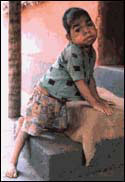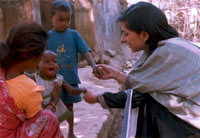Sunita Dubey is a regional coordinator based in New Delhi for Toxics Link India, an information clearinghouse for toxics and related issues.

Monday, 26 Feb 2001
DELHI, India
As usual, I wake up with Monday blues. It takes me almost an hour to reach my office. Typically I enjoy observing the hustle and bustle of city life through the bus window, but today I am busy prioritizing and organizing the work to be done before I leave town tomorrow. I am going to Ranchi to attend an international conference on fossil fuels and climate change.
First thing after reaching the office, I download my email. Among all the regular email, one catches my attention because of its subject: “SOS-Help needed.” This email is from a local activist, Shree Padre, who lives in Kerala, a southern state in India. With the help of the local community, Padre is resisting a government move to aerially spray endosulphan on cashew plantations. For the past year, we have been helping his organization by providing information on endosulphan, a pesticide that has been banned in many countries due to its toxicity and acute health effects. Endosulphan is proposed to be banned globally under the U.N. Environment Programme treaty for “persistent organic pollutants” (POPs). Chemicals categorized as POPs have a highly persistent nature, extreme toxicity at very low concentrations, and the ability to enter the food chain. POPs’ associated health effects include reproductive failure, hormone dysfunction, tumors/cancers, behavioral abnormalities, and gross birth defects.

A disproportionate number of children in the village are born with birth defects.
Shree Padre’s village is small, with just 400 households, and is surrounded by lush, green forest. Most of the inhabitants are farmers practicing sustainable agriculture. However, for the past 25 years, endosulphan has been sprayed on plantations near the village, poisoning the water sources, affecting the villagers’ health, killing birds and insects, and generally disrupting the tranquility of this small hamlet. The villagers’ lives have dramatically changed as residents have become afflicted with diseases previously unknown to them, such as cancer, cerebral palsy, and birth defects. The government has made it a thrice-yearly ritual to send helicopters to spray endosulphan on its cashew plantations, engulfing the whole area in a poisonous cloud.
It took many years to establish the connection between pesticide spraying and the residents’ deteriorating health. Since then, the villagers have knocked on all possible doors to stop the poisonous spraying, but their pleas have fallen on deaf ears. Now they have asked our help in stopping the spraying scheduled for tomorrow.
I am struggling with the question of how to resolve this problem when my colleague, Madhu, walks in the office. I tell her about tomorrow’s spraying, and we sit down to devise a quick strategy.
The first call I make is to the joint director of the central insecticide board, which is the primary agency dealing with pesticide use. He tells me that his organization has not given permission to spray, and moreover, that aerial spraying is not permitted due to its negative health impacts. It takes a lot of talking to persuade him that this is actually happening in a small village despite the residents’ protests. He seems helpless and directs me to another officer, who supposedly is authorized to take action. I know this is just the start of a chain reaction, and that, in the process, I will be directed to many other officials who will give me the same story.
At 2 p.m., I call a high-ranking official in the agriculture ministry. I have to pass intense scrutiny and give a long explanation before I am finally allowed to speak with him. He seems to express concern and tells me that he will look into the matter. I explain the urgency to act, as the spraying will happen tomorrow. He says that he will fax a letter to the concerned state official and gives me his phone number in case I want to follow up. Next, I phone the agriculture production commissioner of Kerala, who is very resistant and not ready to acknowledge the problem. It takes a lot of arguing to make him understand the issue.
I put the phone down and think about how insensitive some people can be. Dealing with government officials is like banging my head against the wall. It’s 4:30 p.m. now, and I still have to organize all the documents to take to the conference. Before leaving, I again call the agriculture ministry to confirm that the letter has been faxed. Then I write a quick email to the local activist, briefing him on the day’s developments.
It’s 6:30 p.m., and I am back in my bus seat, looking at a man by the side of the road selling peanuts and trying to keep them crisp with a hot earthen pot.
Tuesday, 27 Feb 2001
RANCHI, India
I wake up a bit early today because I have to catch a morning flight to Ranchi. At the last minute, I take stock of all the things I have to take to the conference, and I rush to the airport.
It’s 11:00 a.m., and I am comfortably seated in the airplane, looking at the snow-clad Himalayan peaks protruding out of white, puffy clouds. It is the first time I have seen these amazing peaks glittering like diamonds under the early morning sun.
By noon, I reach the hotel where the conference is being held, and after lunch we all leave for a field visit to a thermal power station 60 km from Ranchi. This area also has coal mines to supplement the power from the thermal plant, so it is marred by the effects of both coal mining and coal-fired power plant operation.
We can see smoke coming out of the underground coal mines, and the whole area is covered with black dust. The first village we visit is very close to the mining area. It will be displaced in a year or two, as the company begins to access its coal reserves underneath. Our presence has raised curiosity among the villagers, and the children are very excited to get themselves photographed by international visitors. The villagers complain of groundwater contamination and tell us that at times they get hot water in their wells and pumps. Most of them suffer from skin problems and gastric ailments.
We also visit another village, which is next to a fly ash dyke of the Bokaro thermal power plant, and we see how all the norms for fly ash disposal are being flouted by this company. Villagers tell us that during the summer, it becomes very difficult for them to breathe because of ash blowing in the wind, and that during heavy rains last year, the fly ash slurry gushed into their village. The power plant dumps fly ash, grease, and oil in Damodar River, which flows close to the plant, and we can clearly see black muck on its bank. This river serves as a source of drinking water for many villages situated on its banks. In the absence of any safe drinking water facility, the villagers dig a small hole away from the river and collect water from it for drinking and other household purposes. Though the villagers consider this water to be clean and filtered, it actually contains many toxic heavy metals, which can have adverse health effects.
I just feel that the ignorance of the people is the greatest bliss for these industries. If these people were told about the presence of toxic metals like mercury, arsenic, cadmium, chromium, and lead, would they still consider this water safe?
In India, 70 percent of the nation’s power is generated by coal-fired power stations, and coal found here in India has high ash content and many other impurities. Consid
ering the immensity of the problem, Toxics Link India has done a comprehensive research paper on the problems of fly ash. Our study found that 10 percent of the fly ash generated by thermal power plants is released from the chimney, increasing suspended particulate matter in the air. Inhalation of the metals present in the fly ash is said to be more harmful than ingestion — the health effects range from permanent respiratory disorders to lung cancer.
I have brought this research paper with me and after watching all of this, I plan to give it to a local activist so that salient points can be translated and given to the affected community.
It’s almost 6:00 p.m., and everybody seems both mentally and physically exhausted after seeing the pathetic conditions of these people. By now I have acquainted myself with the other participants, and on our way back we share views on today’s trip.
Wednesday, 28 Feb 2001
RANCHI, India
I am sharing a room with Cecilia, an activist from Ecuador who works with Accion Ecologica. Over morning tea, we brief each other about our work and find we have many common factors, even though we work at two different ends of the world. It’s 8:30 a.m., time to get ready for the conference.
The conference starts with a brief introduction of the participants, who represent 15 different countries. Most of the day consists of presentations on issues concerning coal mining and climate change. It’s 4:00 p.m., and after a refreshing tea break, we are all engaged in a discussion on “factors responsible for a successful campaign.” The topic was prompted by an inspiring presentation by Ramon Sales of the Philippines about a successful campaign against a coal-fired power plant in Negros. Suddenly, this discussion is interrupted by Xavier Dias, who has just heard from a local activist that eight villagers from the Koel-Karo movement have been killed in a police shooting in Tapkara (a village 25 miles from Ranchi). This is one of the villages where a strong people’s movement has been fighting against the construction of dams since 1975.
The Koel-Karo movement is named after two rivers on which dams were supposed to be built. The local community has resisted efforts to build dams on these two rivers that flow through a thickly forested area inhabited by indigenous people. The government has tried to persuade these people with attractive rehabilitation packages, jobs, and infrastructure development, but nothing has deterred them from their path; they value their land, rivers, forest and culture above all else. The strength and longevity of this movement is evidenced by the fact that the third generation has now joined the ongoing struggle.
Today’s incident was triggered as police tried to break the “People’s Curfew” (the local community has barricaded the project area since 1985, and no one is allowed to enter without their permission). One of the youth from Tapkara village died while in police custody. When villagers protested his death in front of the police station, the police opened fire, killing eight people and injuring many others.
Tapkara is located in Jharkhand, an area dominated by tribals that was declared a separate state just three months ago. The new government, in the name of development, is trying to invite various industries into this area. This state is very rich in mineral wealth, which makes it especially vulnerable to development. The government desperately wants the Koel-Karo project to start, as it has strong potential for hydroelectric power generation. Many local people feel this violent incident was meant to scare them, simply so the government can resume the dam construction that has been halted since 1975.
Everyone in the conference is quite dismayed by this news, and the rest of the evening sessions are postponed until the next day. Even the situation in Ramchi is tense, as dead bodies and injured villagers are brought to the civil hospital. By evening, everyone is discussing the issue, and we all agree to release a solidarity statement condemning the killing of innocent tribals in the police shooting. This is the topic of conversation throughout dinner, and the atmosphere remains heavy as news comes in about more casualties.
Back in our room, Cecilia and I end up discussing the repression of indigenous communities for such development projects and go off to sleep with heavy hearts.
Thursday, 1 Mar 2001
JAMSHEDPUR, India
Major newspapers covered yesterday’s event, and the local organizations have planned a protest.
Last night, I decided not to go back to Delhi, and decided instead to visit other neighboring areas facing environmental problems. My first priority is to visit the Jaduguda uranium mines, which is a five-hour drive from Ranchi.
It’s 9:00 a.m., and by now, everyone is finished with his or her breakfast and most of the participants are planning to leave by noon. I have connected with Ravi from a group called Samtha (they work with indigenous people in south India) to take me to the Jaduguda mines.
Now it’s 9:30 a.m., and I am leaving for a uranium mining area with Ravi and Xavier. The ride is very comfortable, and by 2:00 p.m., we have arrived. There are three mining sites operated by Uranium Corporation of India (UCIL), a state-owned company. The mining areas have been cordoned off, so we visit a village situated next to a tailing pond. The village of Thalendi has a population of about 2,000 and is severely affected by radiation from these mines.

A visit to Thalendi.
We visit local activist Ghanshyam Biruli, from Jharkhand Organization Against Radiation (JOAR), and he tells us the heart-wrenching fact that, in a survey of women in a one-kilometer radius of the dumping grounds, 43 percent of pregnancies had failed to go to term, while 17 percent had resulted in stillbirths. All of the women suffered from disrupted menstrual cycles and fatigue. Around 100 children had been diagnosed with skin, lung, or blood cancer.
He tells us that the only protective gear provided to the workers is a small muslin cloth to cover their faces. People in the village now consider begging better than working in these mines, because what they thought would bring jobs and prosperity has given them only physical and mental grief.
I go out to speak to some of the women in the village, and everyone has the same story about her suffering because of these mines. It’s not only the health problems they face, but also the social stigma, as men are not willing to marry girls from these areas because of reproductive disorders. In the past, the villagers would celebrate when a woman in the family got pregnant, but now they dread the news because of rampant stillbirths and mentally and physically handicapped babies.
The villagers take us to the unfenced tailing pond situated on a small hilltop. International norms recommend burying nuclear waste deep underground and disposing treated, low-level waste in well-fenced areas far from human habitation. Here, the pond is only yards away from people’s homes. During the monsoon, an overflow from the mine runs into the river where villagers drink and bathe. Nuclear waste from around India is sent to the Adivasi (indigenous people) homelands and dumped in tailing ponds.
Recently, uranium mining has been proposed in Meghalaya, another northeastern state. Toxics Link India is providing information to people there and linking them with people working in Jaduguda in an effort to save people from similar irreparable mental and physical damages. The government has not taken any action, but they do tell the people they should feel national pride since the uranium for the Pokhran blast came from their area.
It’s time for us to leave for Jamshedpur, as we are staying ov
ernight at Xavier’s house. Back in the car, I think how often poor people are exploited by corporations or states in the name of development or national security. The only comfort I can find is Gandhi ji’s saying, “My faith is brightest in the midst of impenetrable darkness.”
Friday, 2 Mar 2001
RAIPUR, India
Today I have to catch an evening train back to Delhi. Before leaving, I have plans to meet some of the local groups working on environmental and other issues in this region.
I have a breakfast meeting with Goldie and Durga George, who work on industrial pollution. We discuss the problems associated with area steel mills and how Toxics Link can help them with information and follow-up work in Delhi. They tell me about a strategic meeting of various NGOs organized by the Indo-German Social Services Scheme.
At noon, I arrive at the meeting and introduce myself to the organizer, Mr. Jose. He introduces me to the grassroots groups and asks me to make a brief presentation about the work of Toxics Link. In the meeting, I learn about the Indo-German Social Services Scheme’s work and regional environmental issues. All the groups feel that credible, scientific information is the most important tool to strengthen their campaigns. However, most of these groups work in remote areas, where they have no access to the Internet or to other sources of information. I get their addresses to add to our database, so they can receive our fact sheets and newsletters. I also assure them that we will provide informational help from Delhi.
During lunchtime, I meet with Indu Netam, who is trying to get a mining lease for a tribal co-operative, an effort that is the first of its kind in India. According to India’s constitution, no tribal lands can be transferred to non-tribals for exploitation of resources. Indu tells me about the problems faced by the tribal community in fighting for their own resources.
I call my office, as I am eager to find out the status of the endosulphan spraying in Kerala. Madhu tells me that the local community was able to get a stay order on the aerial spraying, which is a big victory for them.
It’s time for me to rush to the station, as my train is at 5:30 p.m. After a hectic day, the train journey gives me the opportunity to relax with a book.

